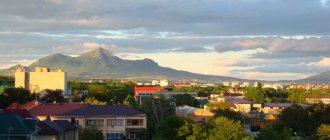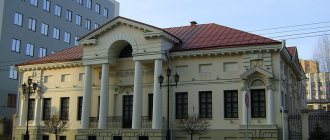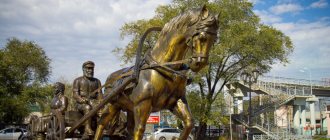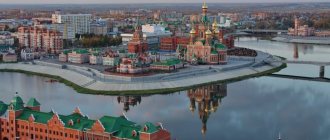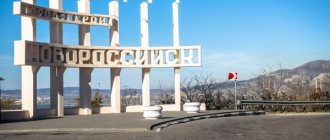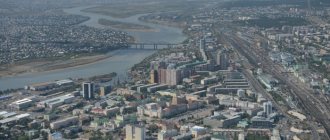City in Rostov region, Russia
| Novocherkassk Novocherkassk | |
| city[1] | |
| Flag Coat of arms | |
| Location of Novocherkassk | |
| Novocherkassk Location of Novocherkassk Show map of Russia Novocherkassk Novocherkassk (Rostov region) Show map of Rostov region | |
| Coordinates: 47°25′20″N 40°05′38″E / 47.42222°N 40.09389°E / 47.42222; 40.09389Coordinates: 47 ° 25′20″ N 40°05′38″E / 47.42222°N 40.09389°E / 47.42222; 40.09389 | |
| A country | Russia |
| Federal subject | Rostov region[1] |
| Based | 1805 |
| Government | |
| • Body | Council of Deputies |
| • Head of Administration | Anatoly Volkov |
| Height | 80 m (260 ft) |
| population (2010 Census)[2] | |
| • General | 168,746 |
| • Evaluate (2018)[3] | 168,022 (-0.4%) |
| • Classify | 108th in 2010 |
| Administrative status | |
| • Subordinate | Novocherkassk City District[1] |
| • Capital from | Novocherkassk urban district[1] |
| Municipal status | |
| • Urban district | Novocherkassk urban district[4] |
| • Capital from | Novocherkassk urban district[4] |
| Timezone | UTC + 3 (MSK [5]) |
| Postal code(s)[6] | 3464xx |
| Dial code(s) | +7 8635 |
| OKTMO I WOULD | 60727000001 |
| Web site | www.novochgrad.RU |
Novocherkassk
(Russian: Novocherkassk, lit.
Novy Cherkassk
) is a city in Rostov Oblast, Russia, located near the confluence of the Tuzlov and Aksai rivers, the latter a distributor of the Don River. Novocherkassk is known as the cultural capital of the Cossacks, and as the official capital of the Don Cossacks. Population: 168,746 (2010 Census);[2] 170,822 (2002 Census);[7]187,973 (1989 Census);[8] 178,000 (1974); 123,000 (1959); 81,000 (1939); 52,000 (1897).
Story
Imperial era
Fund
Novocherkassk was founded in 1805 by Lieutenant General. Matvey Platov, the Ataman of the Don Cossacks, as the administrative center of the Don region. It was founded as a reaction to the original administrative center, Stanitsa
from Cherkassk, which was considered unsuitable as a capital for the Don Cossacks for several reasons.
Cherkassk has been repeatedly flooded for long periods of time due to its low-lying location on the banks of the river. The Don River, and attempts to build a dam to protect the city proved too costly and ineffective.[ citation needed
] In addition, Cherkassk was prone to devastating fires due to its chaotic layout and wooden buildings, and was located away from major roads. Despite the fact that ten of the eleven representatives of the villages that were part of Cherkassk refused to move the capital, Platov still made a presentation to Tsar Alexander I asking for permission to move the capital of the Don Cossacks to another place, and received permission in a decree from the Tsar on August 23 1804
Plan as a new capital of the Don Cossacks
Platov and the engineer François Sainte de Volland developed Novocherkassk as a planned city, deciding to build it on top of a hill known as the "Wolf's Lair" north of Cherkassk, near the confluence of the Tuzlov and Aksai rivers. On November 7, 1804, de Volland and Platov presented Tsar Alexander with a plan for the future city and an extensive report, which described the brightly decorated advantages of the territory chosen for construction. The city is designed in the popular traditions of European urban planning models, with spacious areas, wide avenues and boulevards full of greenery. De Vollan, calling the future of Novocherkassk “small”. Paris" based on numerous city squares, each of which had to include a church, and that the streets began radially around each square. On December 31, 1804, having familiarized himself with the plan and report of Platov and de Vollant, Tsar Alexander personally signed: “Be according to this. Alexander". Construction of the city proceeded slowly, primarily due to the reluctance of most Don Cossacks to leave their homes in Cherkassk, and the new capital was 20 kilometers (12 miles) from the Don River, with which the Cossacks had been closely associated throughout their history. . To compensate, there were even plans to deepen the Aksai River (the Don's distributor), where the new city was located, to eventually change the course of the Don through the city. This plan was abandoned due to lack of funds, and for more than three decades the question of the location of the capital of the Don Cossacks remained unresolved, and the growth of Novocherkassk stagnated.
By 1837, the option of moving the capital to the village of Aksai, also located on a hill near the Don, became popular. However, Tsar Nicholas I personally inspected Novocherkassk and the village of Aksai in the same year, and after returning to St. Petersburg, he ordered the Don Cossacks to leave the capital in Cherkassk due to the complexity and futility of the transfer. In the first half of the 19th century, Novocherkassk was built only as an army center, administrative buildings, guest courtyards, taverns, wine cellars, hotels and generals and noble houses. In the 1850s, industrialization reached Novocherkassk and industrial enterprises were formed, but out of twenty thousand city residents, only a thousand worked in them.
Soviet time
On the eve of the February Revolution, the population of Novocherkassk was about sixty thousand people, of whom about twenty-five thousand served as Cossacks and members of their families, three thousand were nobles, and about five hundred were clergy. Novocherkassk, unlike many Russian cities of that time, had almost no permanent traders or peasants. During the Russian Civil War from 1917 to 1922, Novocherkassk was the center of the Don Army counter-revolution and came under the command of General Alexey Kaledin. The Red Army eventually won and ousted the Whites, who joined the Don Army from Novocherkassk on January 7, 1920.
During World War II, the Wehrmacht from Nazi Germany occupied Novocherkassk from July 24, 1942 to February 13, 1943.
On June 1–2, 1962, events known as the Novocherkassk Massacre occurred when food riots and workers' rights protests broke out following a strike at the Novocherkassk Electric Locomotive Plant, in the city. The protests were suppressed by Soviet Army troops, resulting in 26 protesters killed and 87 injured.
On November 20, 1990, Andrei Chikatilo, one of the most prolific serial killers in the Soviet Union with 56 convicted murders, was detained in Novocherkassk.
Recent history
On October 5–6, 1991, a meeting of the Big Circle of the Union of Cossacks of the Don Military District was held, at which the city was established the status of the historical and modern center of the Don Cossacks, officially making Novocherkassk a city. capital of the Don Cossacks. On July 17–18, 1993, a meeting of the United Supreme Circle of Cossack troops of Russia and abroad took place in Moscow, where Novocherkassk was proclaimed the world capital of the Cossacks.
Novocherkassk
Symbolism
| Flag | Coat of arms |
Administration
346430, Rostov region, Novocherkassk, Platovsky Ave., 59-b.
Phones: +7 (86352) 5-99-11, 5-99-13, fax +7 (86352) 5-99-17
Housing and communal services hotline
Official site
www.novochgrad.ru
Head of the city administration
Lysenko Yuri Evgenievich
Geography
Novocherkassk is one of the large southern Russian cities. It stands out for its history and special appearance: layout, architecture, unique monuments.
Novocherkassk is a city of regional subordination of the Rostov region. It borders with the Oktyabrsky and Aksai rural districts of the Rostov region. The total area of urban land is 12,784.32 hectares. The population is 168.8 thousand people.
Story
The city of Novocherkassk was founded on May 18 (30th according to the new style) 1805 by military ataman Matvey Ivanovich Platov according to the design of military engineer Lieutenant General Franz Devolan. The new capital of the Cossacks, the city of New Cherkassk, was built according to the most modern examples of European architecture of that time and at the same time according to the canons of Cossack culture.
Developing as the administrative capital of the Don Cossacks, Novocherkassk naturally had a predominant population of Cossack origin. But nonresidents also lived there, including people of many nationalities.
During the years of the revolution, it became the only city in Russia where the Provisional Government fled. It was in Novocherkassk that two white armies were formed - the Volunteer and the Don. Novocherkassk from 1917 to January 1920 was the “all-Russian center of counter-revolution.”
With the establishment of Soviet power on January 7, 1920, the city moved from the category of the Cossack capital to a regional, and later city center.
In the second half of the twentieth century, the city became a major industrial, scientific and cultural center of the Don region.
Economy
The basis of the economy of the city of Novocherkassk is industrial production. Its share in the citywide production volume is more than 90%.
Dozens of large and medium-sized industrial enterprises carry out their financial and economic activities in the city.
The city's industrial production is represented by two groups:
- manufacturing industries;
- production and distribution of electricity, gas and water.
Three enterprises of the city - the branch of OJSC OGK-2 Novocherkassk State District Power Plant, LLC PK Novocherkassk Electric Locomotive Building - are the largest.
The branch of JSC OGK-2 Novocherkasskaya GRES is one of the largest power plants in the south of Russia.
PC Novocherkassk Electric Locomotive Plant LLC, part of Transmashholding CJSC, is one of the leading enterprises in the city and the largest in Russia in the production of mainline passenger and freight electric locomotives.
OJSC "EPM - Novocherkassk Electrode Plant" is the largest enterprise in Russia producing graphite electrodes of various sections (from 75 to 710 mm in diameter), used for smelting ferrous and non-ferrous metals.
The group of enterprises producing electrical equipment includes TMH-Electrotech LLC, which produces electric motors, electric generators and transformers.
The main activity of OJSC Aviation Technological Equipment Plant 31 is the repair of non-standard technological equipment for aircraft.
Sladoff LLC operates in the food industry.
Education
The city is proud of its higher educational institutions, which have a centuries-old history.
South Russian State Polytechnic University is one of the leading technical universities in Russia. Novocherkassk State Reclamation Academy, which continues the traditions of the founder of the country’s first scientific school of reclamation, Academician Shumakov, is the country’s basic university in this industry.
In addition to universities, 7 colleges in the city train specialists for all fields of activity. There are 45 kindergartens, 22 educational institutions implementing general education programs.
Culture
Novocherkassk today has significant cultural potential with developed infrastructure. There are 14 municipal cultural institutions in the city.
Far beyond Novocherkassk, the Donskoy Drama and Comedy Theater is famous. V.F. Komissarzhevskaya (Cossack Drama Theater) is one of the oldest theaters in Russia, the first Don Theater.
There are 6 municipal institutions of additional education for children in the field of culture and art in the city. There are 4 municipal cultural and leisure institutions and 2 municipal concert organizations.
The city has a centralized library system, consisting of 9 libraries, on the basis of which library and information centers have been created. In Novocherkassk there is one of the oldest libraries in the region - the Central City Library named after. A.S. Pushkin.
The world's only Museum of the History of the Don Cossacks with departments: House-Museum of the artist I.I. Krylov, House-Museum of the battle painter M.B. Grekova, Ataman Palace.
The Novocherkassk school of painting has long traditions. The city has a city Artists' Club, creative associations "Women's Palette" and "Mishkinskie Bugry".
Social sphere
Novocherkassk is home to 167.2 thousand people of 33 nationalities and nationalities, of which about 11 thousand people are war and labor veterans, 53.5 thousand people are young people aged 16 to 35 years.
The city healthcare system includes 18 treatment and preventive institutions: 12 municipally owned institutions and 6 regional institutions: an anti-tuberculosis clinical dispensary, a psychoneurological dispensary, a dermatovenerological dispensary, an oncology dispensary, a drug treatment dispensary and a specialized children's home.
In order to improve the quality and accessibility of government and municipal services, 7 territorially separate structural divisions of MAU MFC were opened in the city's microdistricts.
Sport
There are 3 sports schools in the city, 2 of which are Olympic reserve schools, in which over 3,200 people play sports. Successfully carries out its activities to strengthen the health of the population and develop summer and winter sports of the MAU State Center "Ermak", which includes the "Ice Palace", the "Ermak" stadium and the "Gazprom for Children" sports and recreation complex with a swimming pool, games room, wrestling room and gyms.
Since 2011, the MAU FOC swimming pool “Dolphin” has been operating in the city.
On the basis of MAU GSC "Ermak" there is a testing center for the VFSK "GTO".
The city has a large number of open sports grounds, which are in municipal, departmental and private ownership, which fully meet the need of the city population for physical education and sports.
Novocherkassk is the historical and current capital of the Don Cossacks
Novocherkassk managed to preserve its historical appearance. Historian V.D. Sukhorukov wrote about the capital of the Don Cossacks: “Straight wide streets and large squares make up the beauty of Novocherkassk.” Novocherkassk is a monument city. Over the past almost two centuries, it has combined a distinctive history, traditionally high culture and scientific and technical potential. With the revival of the Cossacks in the 1990s, Novocherkassk regained its status as the main city of the Cossacks and became the capital of the Great Don Army, as well as the Cossacks of Russia and Abroad.
The pride of the city is the huge triumphal arches (cultural heritage sites of federal significance), erected in honor of the participation of the Don Cossacks in the Patriotic War of 1812.
Two identical arches were built according to the design of the capital’s architect A.I. Ruska in 1817 during the life of the founder of the city, the famous Don Ataman, hero of the Patriotic War of 1812, Count Matvey Ivanovich Platov.
Among the major monuments of the city, one can note the monuments to the founder of the city, military ataman, Count M.I. Platov (1853), a monument to the legendary Cossack Ermak (1904), the hero of the Caucasian wars, General Baklanov (1911).
The city is home to more than 250 cultural heritage sites of federal, regional and local significance.
During the years of democratic reforms, the process of revival of the Don Cossacks began. Novocherkassk was recognized not only as historical, but also as the current capital of the Don Cossacks and the Cossacks of all Russia. Foreign Cossack diasporas recognize Novocherkassk as the world capital of the Cossacks.
Sights of the city of Novocherkassk
Culture and religion
This Lutheran Church in Novocherkassk is currently used by the Baptist community.
Novocherkassk was once an archiepiscopal church of the Greek Orthodox Church and has a huge neo-Byzantine cathedral (1904), as well as the Church of Our Lady of the Don (2013), the palace of the ataman of the Cossacks, and monuments to Matvey Platov and Ermak Timofeevich (Mikhail Mikeshin, 1904). During the bicentennial celebrations in September 2005, another monument dedicated to the reconciliation of the white and red Cossacks was unveiled in the presence of party members. Romanov family.
Novocherkassk Airport
Novocherkassk does not have its own airfield. The nearest civilian airport is in Rostov-on-Don. The distance from the center of Novocherkassk to the airport is 38 km. The airfield has the status of a federal facility. Operating hours: 24 hours a day.
The airport serves aircraft of Russian and foreign airlines: Pobeda, Alrosa, Nordavia, Turukhan, Russia, Aeroflot, Turkish Airlines. Popular destinations for regular and charter flights: Dubai, Moscow, St. Petersburg, Samara, Prague. The airport's annual passenger traffic is more than 2.5 million people.
Recommendations
Notes
- ^ a b c d f
Law No. 340-ZS - ^ a b
Federal State Statistics Service of Russia (2011).
“All-Russian Population Census 2010. Volume 1" [All-Russian Population Census 2010, vol. 1]. All-Russian Population Census 2010 [All-Russian Population Census 2010]
(in Russian). Federal State Statistics Service. - "26. The size of the permanent population of the Russian Federation by municipalities as of January 1, 2022.” Federal State Statistics Service. Retrieved January 23, 2022.
- ^ a b c
Law No. 237-ZS - "On the calculation of time." Official Internet portal of legal information
(in Russian). June 3, 2011. Retrieved January 19, 2022. - Post office. Information and computing center of OASU RPO. ( Post office
).
Search for postal facilities ( Search for postal facilities
) (in Russian) - Federal State Statistics Service of Russia (May 21, 2004). “The population of Russia, the constituent entities of the Russian Federation as part of federal districts, urban settlements, urban settlements, settlements, settlements is 3 thousand or more people” [Population of Russia, its federal districts, constituent entities of the federation, districts, urban settlements, rural settlements - administrative centers, rural settlements with a population of more than 3000 people] (XLS). All-Russian Population Census of 2002 [All-Russian Population Census of 2002]
(in Russian). - “All-Union Population Census of 1989. The actual population of the union and autonomous republics, autonomous regions and districts, territories, regions, urban settlements and villages-paradise-city relations.” novochgrad.ru
(in Russian). Novocherkassk. Retrieved February 5, 2022.
Where is Novocherkassk located?
Novocherkassk is the capital of the Don Cossacks, a city located in the Rostov region and is an urban district.
It is located on a steep, steep hill between two rivers: Tuzlov and Aksai. The central part of the city is located on a hill, which is surrounded by floodplains. The territory of the city borders the Aksai and Oktyabrsky rural areas. At the base of the hill there are shales, sandstones, and dense limestone. The approximate population of the city is 168 thousand people, the total area of Novocherkassk is 128 square kilometers. The climate in the city of Novocherkassk is temperate continental with excess heat and lack of moisture in summer, and snowy, cool winters. The annual precipitation rate is 605 mm. Night emissions often occur in the city. The wind blows smog and smoke from the industrial area of the city to the residential area. Because of this, black specks can be seen on clothes that are left to dry outside. Every year Novocherkassk is included in the list of the most polluted cities in Russia. In the city, there is a serious lack of green space in residential areas, which slows down the process of air purification.
Novocherkassk is located in the same time zone as Moscow, the offset relative to Coordinated Universal Time (UTC) is +3.
